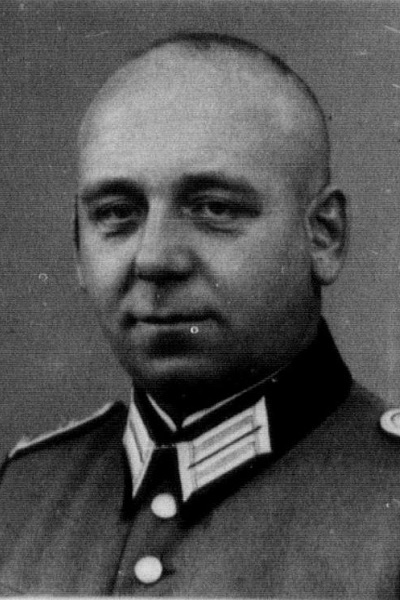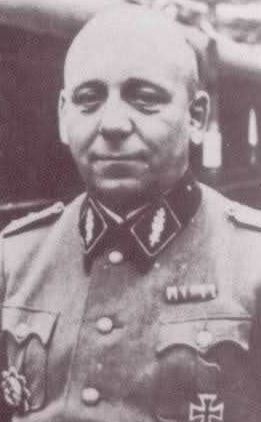Heilmann, Nikolaus (Waffen SS)
- Date of birth:
- April 20th, 1903 (Gundhelm-Schlüchtern/Hesse, Germany)
- Date of death:
- January 30th, 1945 (Danzig/Westernprussia, Germany)
- Service number:
- SS-Nr.: 327.324 // NSDAP-Nr.:
- Nationality:
- German
Biography
Op January 29th, 1945, Heilmannn together with his Ordonnanzoffizier and his driver, went away in search for the Staff of the V. SS-Freiwilligen-Gebirgskorps. Near the Truppenübungsplatz Wandern (Danzig/Westernprussia), they ran into a patrol of the Soviet forces. The driver managed to escape but both Heilmann and his Ordonnanzoffizier are considered missing in action since January 30th, 1945. During his missing he was promoted to SS-Brigadeführer/Generalmajor der Waffen-SS
Promotions:
April 1st, 1929: Leutnant der Schutzpolizei;
April 1st, 1932: Oberleutnant der Schutzpolizei;
?: SS-Hauptsturmführer;
April 20th, 1941: Major der Schutzpolizei/SS-Sturmbannführer;
January 5th, 1942: Oberstleutnant der Schutzpolizei/SS-Obersturmbannführer;
June 21st, 1943: SS-Standartenführer;
February 11th, 1944: SS-Oberführer;
?: SS-Brigadeführer/Generalmajor der Waffen-SS.
Career:
April 1st, 1925: Schutzpolizei;
?: Zugführer;
?: Adjutant;
?: Taktiklehrer, Polizei-Offizierschule, Köpenick;
May 1st, 1939: SS-Oberabschnitt Ost;
October 1939: Adjutant, Polizei-Schützen-Regiment 3;
September 12th, 1940: Ia (1. Generalstabsoffizier), SS-Polizei-Division/
Führer, Polizei-Schützen-Regiment 1;
June 1943: Division "Das Reich";
August 1943: Chef des Stabes, IV. SS-Panzerkorps;
?: Chef des Stabes, VI. SS-Armeekorps;
?: m.d.F.b., 15. Waffen-Grenadier-Division der SS (lettische Nr.1);
February 17th, 1944: Kommandeur, 15. Waffen-Grenadier-Division der SS (lettische Nr.1);
July 21st, 1944: Führerreserve OKH;
?: Divisionsführerlehrgang;
December 12th, 1944: Kommandeur, 28. SS-Freiwilligen-Panzergrenadier-Division „Wallonien".
Do you have more information about this person? Inform us!
- Period:
- Second World War (1939-1945)
- Awarded on:
- June 15th, 1940
- Period:
- Second World War (1939-1945)
- Awarded on:
- September 10th, 1941
- Period:
- Second World War (1939-1945)
- Rank:
- Oberstleutnant im Generalstab (Lieutenant-colonel to the General Staff)
- Unit:
- Führer, Polizei-Schützen-Regiment 1, SS-Polizei-Division, Waffen-SS
- Awarded on:
- August 3rd, 1942
- Period:
- Second World War (1939-1945)
- Awarded on:
- June 21st, 1942
- Period:
- Second World War (1939-1945)
- Awarded on:
- August 18th, 1942
- Period:
- Second World War (1939-1945)
- Rank:
- SS-Oberführer (Brigade General)
- Unit:
- Kommandeur, 15. Waffen-Grenadier-Division der SS (lettische Nr.1), Waffen-SS
- Awarded on:
- August 23rd, 1944
“Following a long series of exhausting and eventful battles against overwhelming enemy infantry and tank forces, which brought heavy casualties with it, the 15. Waffen-Gren.Div. der SS (lett. Nr. 1) reached its intended position on the 11.07.1944. However by now the Latvian infantry had been shaken so much by the previous battles that it was expected that they would not offer serious resistance in the face of strong enemy attacks.
Although the right neighbouring division (23. Infanterie-Division) had taken significant losses of its own, it understood the situation. However in the sector of the left neighbour (19. Waffen-Gren.Div. der SS) a large contingent of the Latvian infantry had been thrown into a panicked flight as a result of a surprise enemy tank attack. As such a firm front no longer existed except on the southern wing of the Division. On the grounds of this fact it could not be expected that the 15. Waffen-Gren.Div. der SS would hold out any more if the enemy pressure continued. This in turn would create a danger that, if a hole in the frontline was indeed opened up, the important road junction and bridges at Opotschka would be open to a Russian thrust.
In this dangerous situation SS-Oberführer Heilmann decided to compel his Division to unconditionally hold the Odenwald position. He would personally go forward to his subordinate Kompanien and ensure that they did not retreat. It is exclusively on account of the handful of German SS officers, NCOs and men under the leadership of the extremely distinguished SS-Oberführer Heilmann (commander of the 15. Waffen-Gren.Div. der SS) that the Division was subsequently able to offer renewed resistance and maintain contact with the neighbouring divisions.
Throughout this difficult combat situation SS-Oberführer Heilmann rushed from Kompanie to Kompanie without regard for his own well-being. He persevered in the foremost line by both day and night under heavy artillery and infantry fire. In both fully open terrain and that which was partially forested, he confronted fleeing Latvian Grenadiers and their leaders, compelling them to go back to the front with either words or violence. His heroic dutifulness and his unbending will to resist made certain that the wavering Latvian units were able to hold out under fire, while furthermore ensuring that the potential Russian breakthrough towards Opotschka in the sector of the battered 15. Waffen-Gren.Div. der SS (one that could have created disastrous consequences for the whole north wing of the 16. Armee) was averted.
On the grounds of the outstanding bravery he displayed here, which resulted in the timely prevention of the danger to the north wing of the 16. Armee, I hold SS-Oberführer Heilmann as being fully worthy of the award of the Knight’s Cross to the Iron Cross.”
Sources
- Photo 1: Igor Poul
- Photo 2:
- Photo:
- .: SS-Oberführer Nikolaus Heilmann Vermisst January/February 1945
- - PATZWALL, K. & SCHERZER, V., Das Deutsche Kreuz 1941-1945, Band II, Verlag Klaus D. Patzwall, Norderstedt, 2001.
- Vorschlag DKiG.
- Die Ordensträger der Deutschen Wehrmacht (CD), VMD-Verlag GmbH, Osnabrück, 2002
- Die Träger des Ritterkreuzes des Eisernen Kreuzes 1939-1945
- Microfilm Publication A3343. US National Archives.










